Affiliate links on Android Authority may earn us a commission. Learn more.
State of Mobile Networks: USA 2017
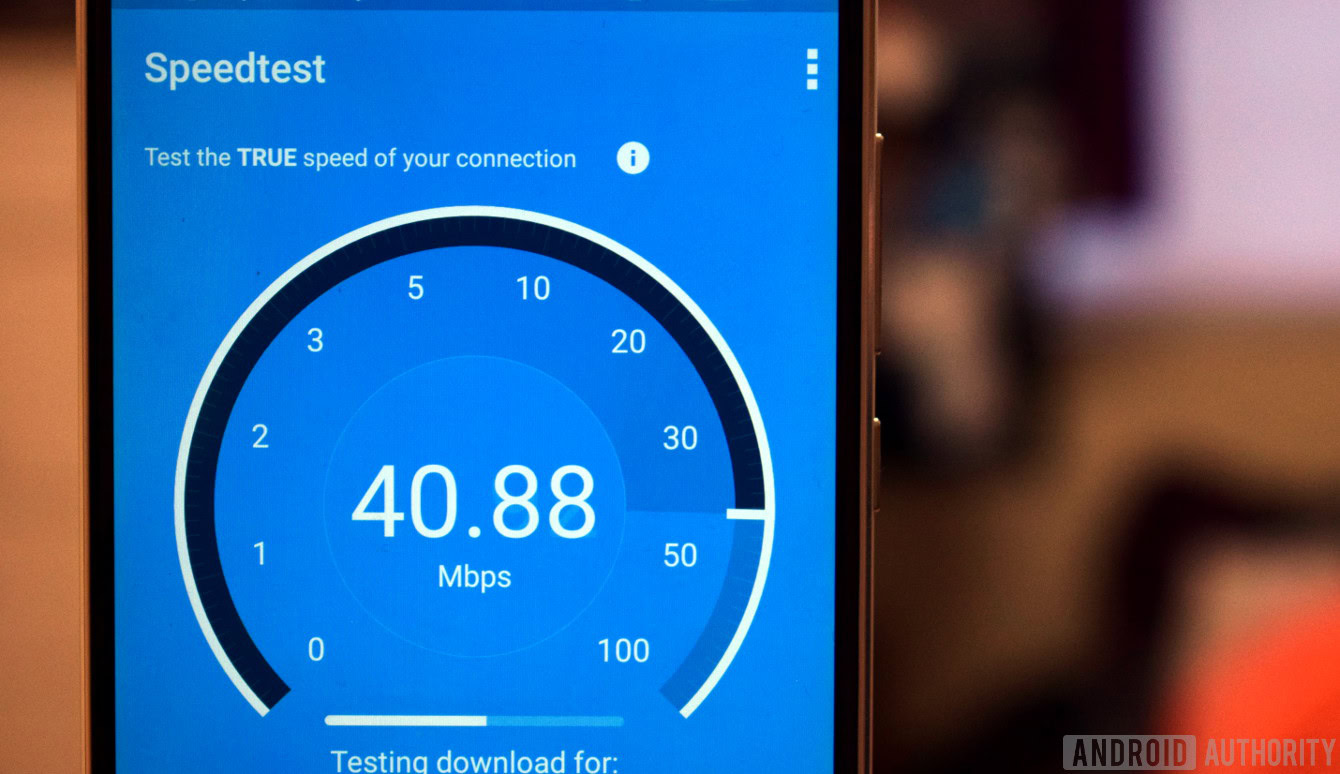
OpenSignal is back with another yearly investigation into the state of the major mobile networks in the US. The data looks at the 3G and 4G data speeds offed by the big four – AT&T, Sprint, T-Mobile, and Verizon – along with latency data and network availability. If you’re keen to know which is the best and most reliable network to pick for your next contract, here’s the information you need to see.
Data speeds
According to the research, it’s a tie between Verizon and T-Mobile for the fastest 4G LTE network in the US, with 16.89Mbps and 16.65Mbps average speeds respectively (as seen by users). AT&T is not far behind on 13.68Mbps, but Sprint is considerably slower on average at just 9Mbps.
It's a tie between Verizon and T-Mobile for the fastest 4G LTE network in the US, with 16.89Mbps and 16.65Mbps average speeds respectively
Although it’s a closely-run race for 4G, T-Mobile retains its title as the fastest 3G network in the US, with 4Mbps typical, followed by AT&T on 3Mbps. Verizon and Sprint both clock in below 1Mbps, meaning a much slower experience on average when roaming out of 4G range. Although we should note that 3G speeds are becoming increasingly irrelevant, as the time spent on these connections is barely registering anymore in OpenSignal‘s research.
The graph below compares the average download speeds achieved by customers on their 4G LTE connections, 3G connections, and a typical usage result that shows the average speed seen by users when moving between 4G and 3G across a carrier’s network.
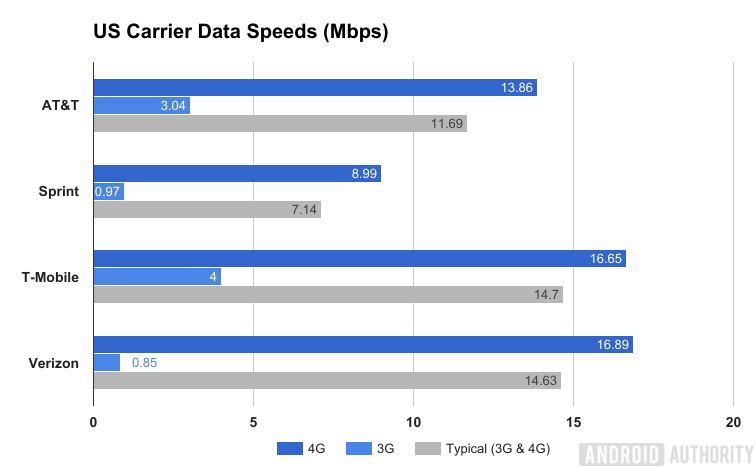
This situation tells a different story to just a few months ago. Back in August, OpenSignal‘s look at the US carrier market revealed that T-Mobile was edging ahead with 4G LTE data speeds. At the time, T-Mobile’s LTE speeds were clocked at 16.3 Mbps, just ahead of Verizon’s 15.9 Mbps. While both are a little faster today, it appears that Verizon has managed to successfully close the gap.
Looking back even further to March 2016, US customers will probably have noticed an improvement to their 4G LTE and 3G speeds, regardless of which carrier they are on. Back in 2016, T-Mobile led the way with 12.26Mbps, followed by Verizon on 11.98Mbps, AT&T on 7.93Mbps, and Sprint on 6.56Mbps.
While all carriers have improved their 4G LTE speeds, its AT&T that has seen the biggest boost, up a whopping 75 percent compared with last year.
While all carriers have improved their 4G LTE speeds, its AT&T that has seen the biggest boost, up a whopping 75 percent compared with last year. The other three major carriers have all improved their 4G LTE speeds by between 35 and 41 percent. AT&T has also seen the biggest improvements in its 3G speeds, showing almost a 50 percent improvement from 2.22Mbps to around 3Mbps.
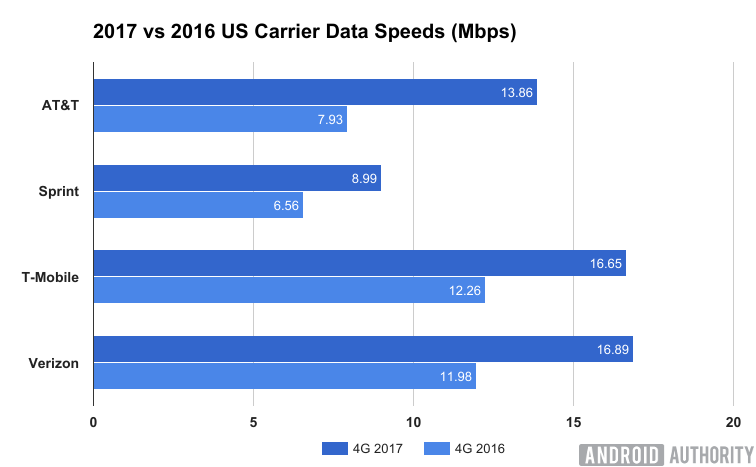
This notable boost to 4G LTE data speeds has come following a number of LTE-Advanced activations up and down the country. In August last year, Verizon announced it was implementing its LTE-A upgrade across its 4G network, T-Mobile has been upgrading its network with similar technologies for a while already and is planning further boosts, and Sprint has just switched on its three-carrier aggregation technology too.
These 4G-LTE rollouts have seen major speed boosts in certain cities, with Verizon’s New York coverage hopping from 17.4Mbps to 22Mbps last summer. Speaking of cities, Verizon ranked highest in speed in 14 of the 36 cities analyzed, compared to four cities for T-Mobile, and one for AT&T. Seven other metro areas results in a speed tie for Verizon and T-Mobile.
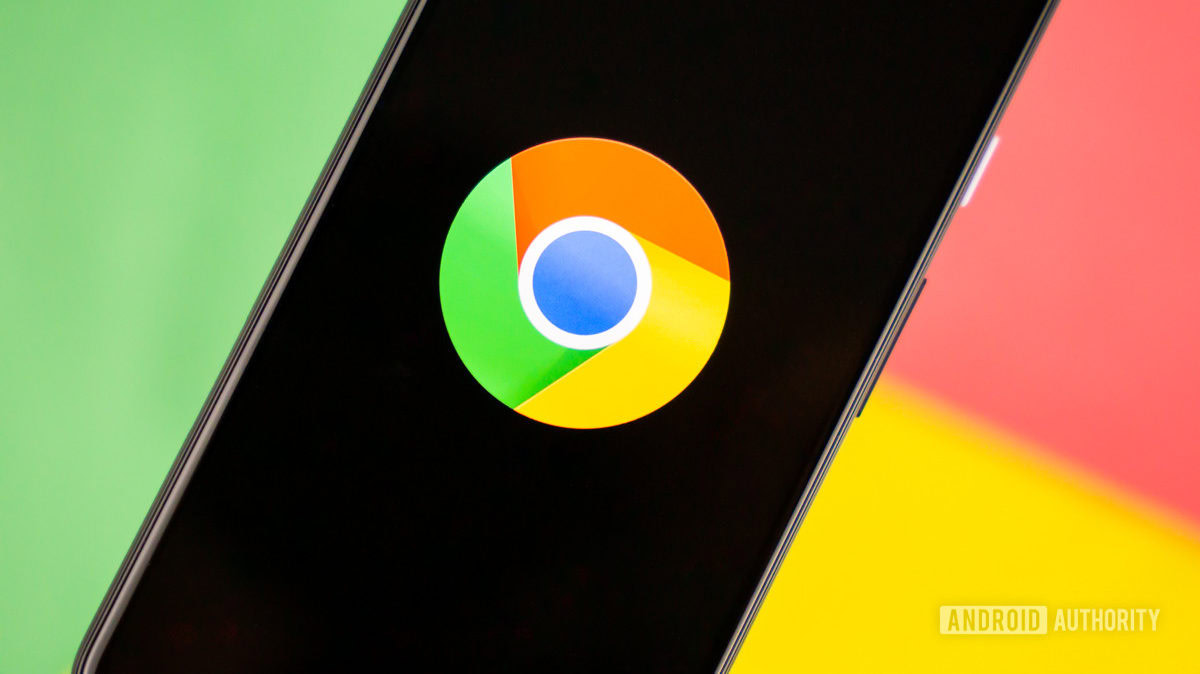
Latency
Before we leave data speeds behind, we should take a little look at latency. Latency is an important factor in the overall experience, as fast data speeds don’t provide a snappy website response if there’s a large delay between data transfer points. The is particularly important for things like online gaming, video calls, and voice over LTE (VoLTE).
Sprint led the way with latency last year, but it’s now virtually a neck and neck affair across all networks. Verizon edges out ahead with a 59.8ms typical 4G latency, followed by Sprint on 61.3, T-Mobile on 61.6, and AT&T on 65.6, which are all pretty indistinguishable from each other.
3G shows a wider variety of results, with T-Mobile leading on 115.8ms, followed by AT&T’s 129.5, Sprint on 153.5, and Verizon with 173.3ms. T-Mobile and AT&T are notablly ahead here, but, as we said before, 3G is becoming less important as 4G LTE network coverage continues to strengthen.
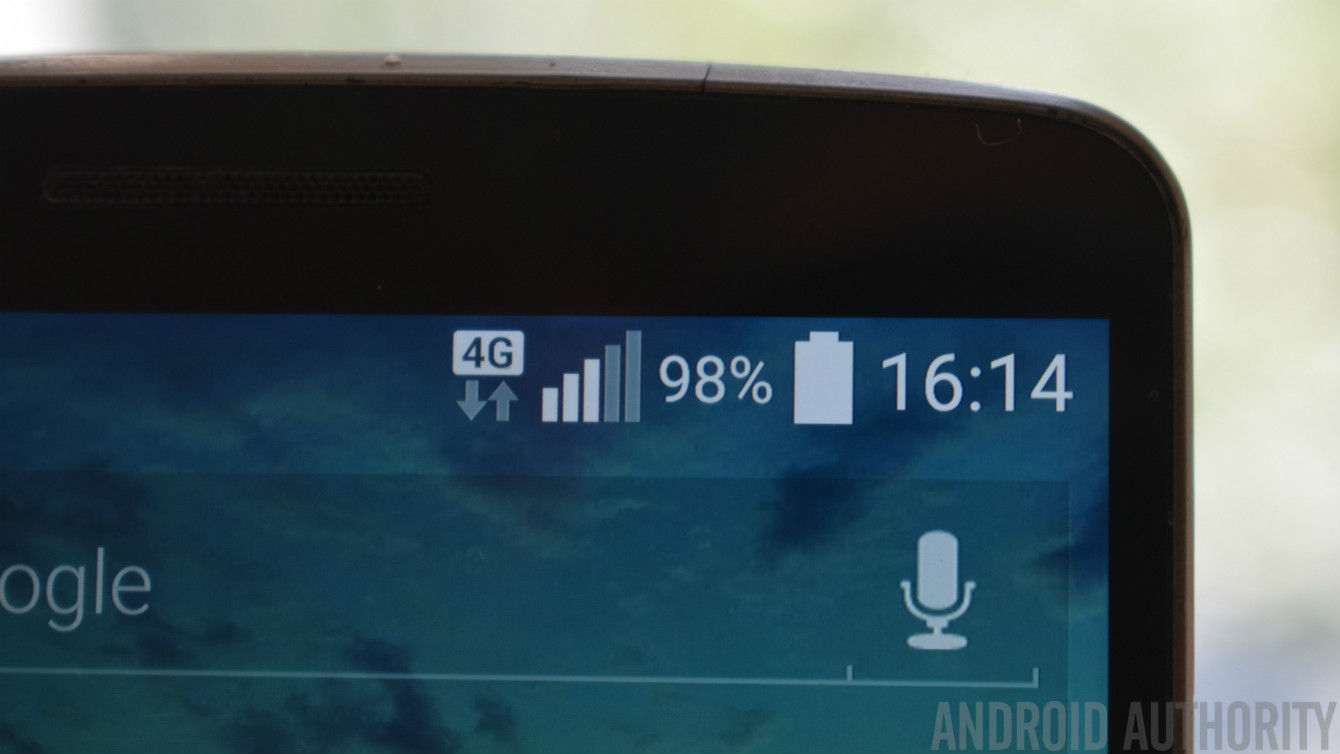
Network Coverage
Network coverage is just as important as speed, and the report suggests further improvements in 4G network coverage for many consumers over the past year. Verizon is still narrowly out in front, with customers able to connect to a 4G network 88.2 percent of the time on average.
Verizon customers are able to connect to a 4G network 88.2 percent of the time on average.
T-Mobile is right behind on 86.6 percent, followed by AT&T with 82.2 while Sprint is in last place with 76.8. Based on figures from last year, it seems that T-Mobile has been able to close its few percentage points gap with Verizon, bringing it essentially neck and neck.
Although still offering the least regular access to 4G overall, Sprint has done a considerable job of improving access over the past year and is finally starting to close the gap with the competition. Sprint customers are now seeing 4G LTE data an extra 6.8 percent of the time. T-Mobile has shown similar improvements with a 5.4 percent boost to time with a 4G connection, and has now surpassed AT&T for coverage time.
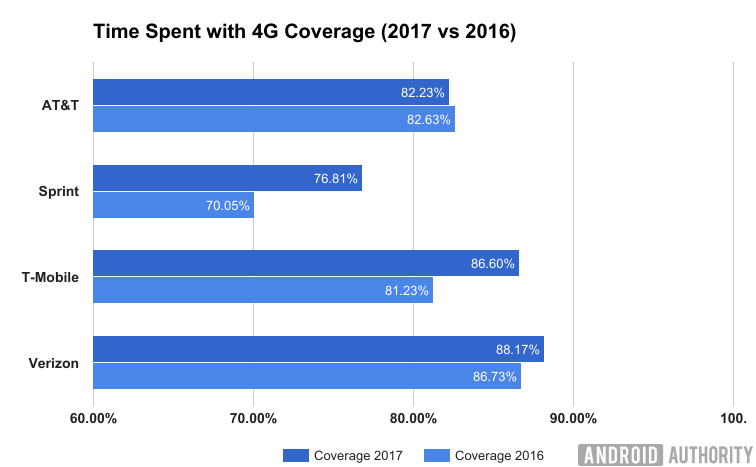
It’s worth pointing out that this data doesn’t actually tell us about area covered across the US. Instead, it simply tells us how regularly customers were able to connect to 4G on their respective networks, and contains no information about 3G availability. Therefore, this make it more of an indication of population coverage rather than overall area, but this is arguably what counts the most.
Wrap Up
Overall, OpenSignal finds that there’s a tie between T-Mobile and Verizon for the best network in the US, both in terms of coverage offered to consumers and their average 4G data speeds. While T-Mobile held speeds steady in the past 6 months, Verizon has closed a 1Mbps gap, and over the past year both have seen a major boost to data speeds. Just as Verizon has been expanding its LTE capacity, T-Mobile has been closing its coverage gap on its biggest competitor, making the two both very compelling options.
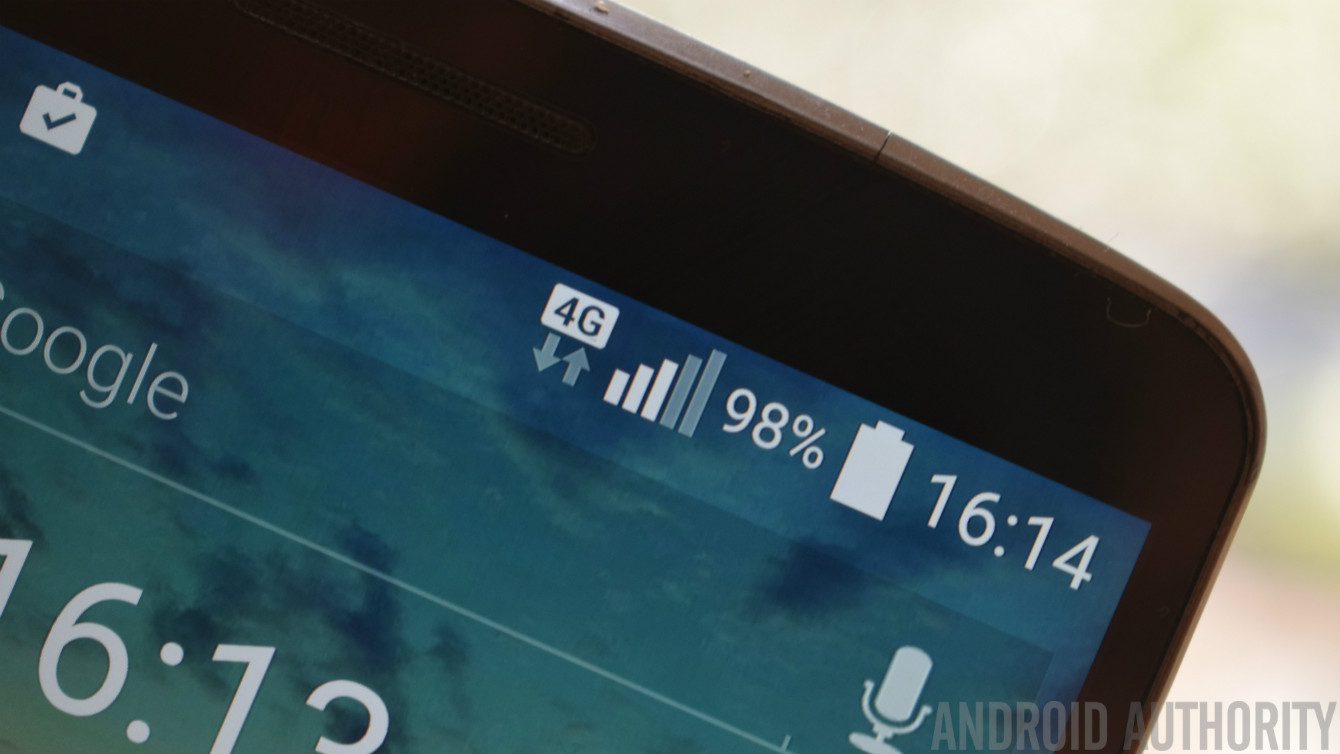
On a global scale, the US is still quite far behind other countries. All four of the major operators are still slightly behind the 17.4 Mbps global average speed offered by 4G networks, although this gap is narrowing. That said, a number of carriers are able to beat these speeds in a number of cities and continued investments into LTE-A rollouts should see speeds continue to increase over the coming year.
Be sure to check out OpenSignal’s full report for a breakdown of the numbers and the researchers’ take on the state of US networks.